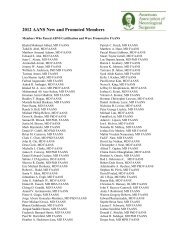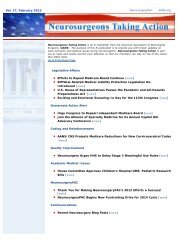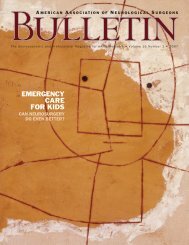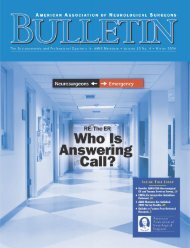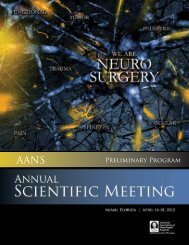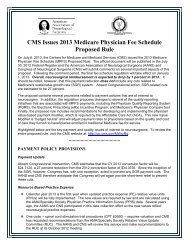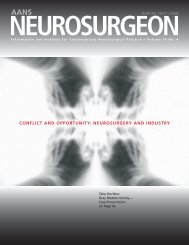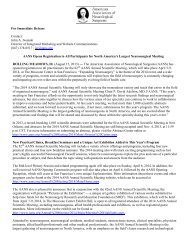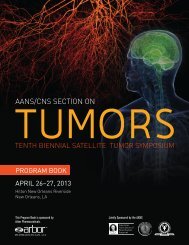view PDF - American Association of Neurological Surgeons
view PDF - American Association of Neurological Surgeons
view PDF - American Association of Neurological Surgeons
Create successful ePaper yourself
Turn your PDF publications into a flip-book with our unique Google optimized e-Paper software.
B OOKSHELF G ARY V ANDER A RK, M D<br />
A Tale <strong>of</strong> Neurosurgery’s Founder<br />
A Compelling Cushing Inspired a Specialty<br />
Harvey Cushing:<br />
A Life in Surgery,<br />
by Michael Bliss,<br />
2005, Oxford<br />
University Press,<br />
591 pp., $40<br />
($26.40 for AANS<br />
members).<br />
Canadian historian Michael Bliss,<br />
MD, author <strong>of</strong> William Osler: A Life<br />
in Medicine, has written a new book<br />
about neurosurgery’s founder, Harvey<br />
Cushing. It is a book that everyone<br />
should read.<br />
Bliss based this book on a host <strong>of</strong> Cushing<br />
family papers unavailable to earlier<br />
biographers. As a result, this is a less constrained<br />
and more personal biography.<br />
Cushing still comes through as a daring<br />
innovator and icon, but he is also revealed<br />
as a real person with many foibles.<br />
Born in Cleveland in 1869, Cushing<br />
graduated from Yale in 1891 and Harvard<br />
Medical School in 1895, staying in Boston<br />
for an internship at Massachusetts General<br />
Hospital. Then Baltimore beckoned with<br />
its new, graciously endowed Johns Hopkins<br />
Hospital and Medical School. Halsted,<br />
Welch, Kelly and Osler all influenced Cushing,<br />
although during his training Cushing<br />
had limited contact with Halsted, but it was<br />
Osler who quickly became a surrogate<br />
father figure for the young surgical pioneer.<br />
A most significant part <strong>of</strong> Cushing’s<br />
development then followed in his “Wanderjahr”<br />
<strong>of</strong> 1900–01, when he visited Europe.<br />
There, Cushing was shocked by the lack <strong>of</strong><br />
surgical asepsis, concern for the feelings <strong>of</strong><br />
the patients and consistency <strong>of</strong> surgical<br />
techniques. He also did the research that led<br />
to elucidation <strong>of</strong> the “Cushing reflex.”<br />
The next year, Cushing married Kate<br />
Crowell and they moved into the house next to<br />
the Oslers in Baltimore. Cushing was declared<br />
the neurosurgical specialist among the Hopkins<br />
surgeons. His interest in brain surgery<br />
resulted from his ability to successfully treat<br />
trigeminal neuralgia by gasserian ganglionectomy.<br />
As a result, he began to do brain tumor<br />
operations, and in 1902 performed a successful<br />
nerve anastamosis.<br />
Before 1900 more than 500 general surgeons<br />
in the United States had done operations<br />
on the brain. Cushing, however,<br />
brought to the then-dismal field a highly<br />
developed set <strong>of</strong> techniques to control<br />
bleeding, crucial knowledge <strong>of</strong> and sensitivity<br />
to the problem <strong>of</strong> intracranial pressure,<br />
an awesome dexterity, and an equally<br />
He was the kind <strong>of</strong> man<br />
you would work with,<br />
admire and respect, but<br />
not one you would like.<br />
awesome combination <strong>of</strong> enthusiasm and<br />
determination to succeed.<br />
During the first decade <strong>of</strong> the 20th century,<br />
Cushing established neurosurgery as a<br />
specialty. He developed subtemporal decompression<br />
as his basic intracranial operation. It<br />
was his all-purpose response to any cerebral<br />
symptomology. Halsted is said to have commented<br />
during these years that he didn’t<br />
know whether to refer to “poor Cushing’s<br />
patients or Cushing’s poor patients.”<br />
But he also increasingly dedicated himself<br />
to the pituitary toward the end <strong>of</strong> that<br />
decade. By 1912 he had data on 48 patients<br />
and wrote The Pituitary Body and Its Disorders.<br />
It was not until many years later that he<br />
described the syndrome <strong>of</strong> hypersecretion<br />
due to a basophilic adenoma that came to be<br />
known as Cushing’s syndrome.<br />
Cushing is not presented in this book as the<br />
well-rounded person we would like our residents<br />
to become. He was not a good husband;<br />
he was an absentee father, and in the operating<br />
room he could be peevish and mean. One<br />
Hopkins resident said, “He was the kind <strong>of</strong><br />
man you would work with, admire and<br />
respect, but not one you would like.”<br />
World War I, in which Cushing served<br />
two tours <strong>of</strong> duty, definitely took its toll.<br />
While in France he probably had the dreadful<br />
influenza and then post-flu Guillain-<br />
Barre syndrome. This, combined with<br />
Berger’s disease made worse by his smoking,<br />
resulted in significant pain and lower extremity<br />
disability. He also learned something<br />
from the war, however—how to operate<br />
more rapidly. By the time the war ended, he<br />
was able to do eight major cases in a day.<br />
I particularly enjoyed the portions <strong>of</strong><br />
this book that deal with the relationship<br />
between Cushing and Osler. The book’s<br />
most moving scene is the death <strong>of</strong> Osler’s<br />
son, Revere, on the operating table in Flanders.<br />
William Osler himself died in December<br />
1919, and within a few months his<br />
widow asked Cushing to write his biography.<br />
Cushing responded by doubling his<br />
workload to write more than a million<br />
words about his mentor. The final work was<br />
edited down to the two-volume The Life <strong>of</strong><br />
Sir William Osler, published in 1925. One<br />
year later Cushing was awarded the Pulitzer<br />
Prize in biography for this work.<br />
Bliss refers to Cushing as “the Babe Ruth<br />
<strong>of</strong> his game.” Interestingly, his subject<br />
enjoyed the athletic analogy, too. Cushing<br />
wrote to his oldest son, who was struggling<br />
with his studies, “Life all round is a kind <strong>of</strong><br />
sporting event and the best any <strong>of</strong> us can do<br />
is to try continually to improve our game.”<br />
Reading this book will help you improve<br />
your own game. 3<br />
Gary Vander Ark, MD, is director <strong>of</strong> the Neurosurgery<br />
Residency Program at the University <strong>of</strong> Colorado. He is<br />
the 2001 recipient <strong>of</strong> the AANS Humanitarian Award.<br />
Volume 14, Number 4 • AANS Bulletin 41



